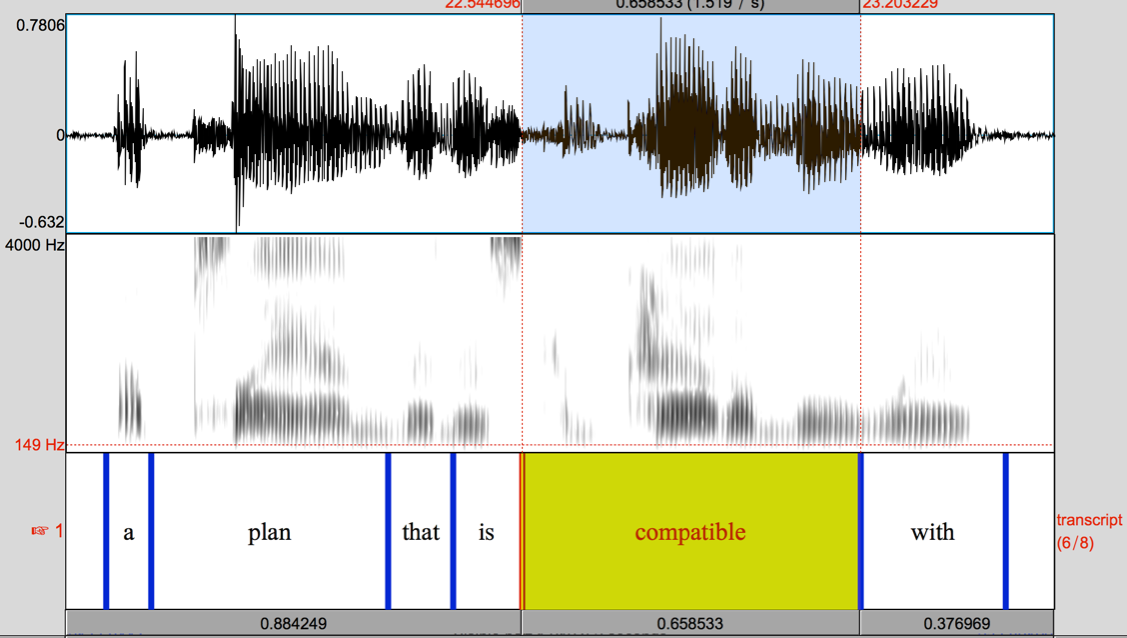1. Phonetic duration measurements
The point of this section is to get you started on using a computer program for acoustic analysis of speech. Your task is to embarrass Chuck Todd, who used to be the host of NBC's Meet The Press.
Todd's first interview as host was with President Barack Obama, broadcast on 9/7/2014. About eight and a half minutes into the 35-minute interview, Todd asserted, in a very serious voice, "You've not said the word 'Syria' so far in our conversation." Unfortunately for Todd, Obama had in fact said "Syria" four times at that point, most recently towards the end of the previous turn. (See here for some further details, if you're interested.)
Choose a convenient folder to work in, and download Obama.wav, a 30-second-long selection from the interview's audio, containing Todd's statement along with part of Obama's previous turn. Depending on your computer and browser, you may be able to do this simply by clicking on the link -- if not, try right-click>>Save link as... (typical for Windows) or control-click>>Save link as... (typical for macOS).
Now download the free program Praat. You can probably find all the needed instructions here: "Creating an Aligned Transcript in Praat". If you want to learn more, you can ask in your recitation section, or delve into online tutorials like this one.
Your task is
(1) to create an aligned transcript (as a Praat "TextGrid") for the 30-second selection;
(2) to measure the duration of Obama's rendition of the word "Syria" (in milliseconds);
(3) to measure the duration of Todd's rendition of the word "Syria" (in milliseconds);
(4) to measure the duration of the stretch between the end of Obama's "Syria" and the start of Todd's "Syria" (in seconds, with three digits after the decimal point).
(A part of) Your transcript will look like something like this this in Praat -- I've selected the word "compatible", indicating that it's 659 milliseconds long:

If you like, you can save time by transcribing in chunks between silent pauses, rather than finding the boundaries of every word -- except as required by the instructions above. So part of your transcript might look like this:

But you'll find that trying to segment (at least part of) the audio into words will be an educational experience.
You can take measurements directly from the interactive editing window in Praat -- but you should also learn to save your TextGrid as a text file for future reference, and so you should hand in your saved TextGrid along with the three requested measurements.
2. Simple English Phonetic Transcription
Write the first four lines of "Fit the First" of Lewis Carroll's poem "The Hunting of the Snark", in IPA, using the system discussed in the lecture on English pronunciation:
“Just the place for a Snark!” the Bellman cried,
As he landed his crew with care;
Supporting each man on the top of the tide
By a finger entwined in his hair.
You can generate IPA symbols using online apps like this web one.
Assume careful "dictionary" pronunciation of each word, using "standard" modern American pronunciations (even though the poem's author was a 19th-century Englishman).
3. Phonetic Transcription of English Nonsense
In Jon Stewart's 1997 interview with George Carlin, this passage starts at about 1:17.6:
well- well uh to- to go backwards with the question,
don't forget, what we do is oratory.
It's rhetoric.
It's not just comedy, it's a form of rhetoric
and- and with rhetoric, you- you look and you listen for rhythms,
you- you look for ways
to sing at the same time you're talking, and to go
[skat-like phrases, based on rhythmic patterns of /d/-initial syllables...]
Your task is to provide a phonetic transcription of the nonsense syllables at the end:
You'll find that it's easier to transcribe accurately if you download the recording to your personal computer, and use audio software like Praat or Audacity to select and listen carefully to arbitrary short segments. (And you don't need to try to transcribe Jon Stewart's laugh at the finish...)
4. Extra Credit
If you're feeling ambitious, try creating an accurate close phonetic transcription of George Carlin's first phrase "well- well uh to- to go backwards with the question"...